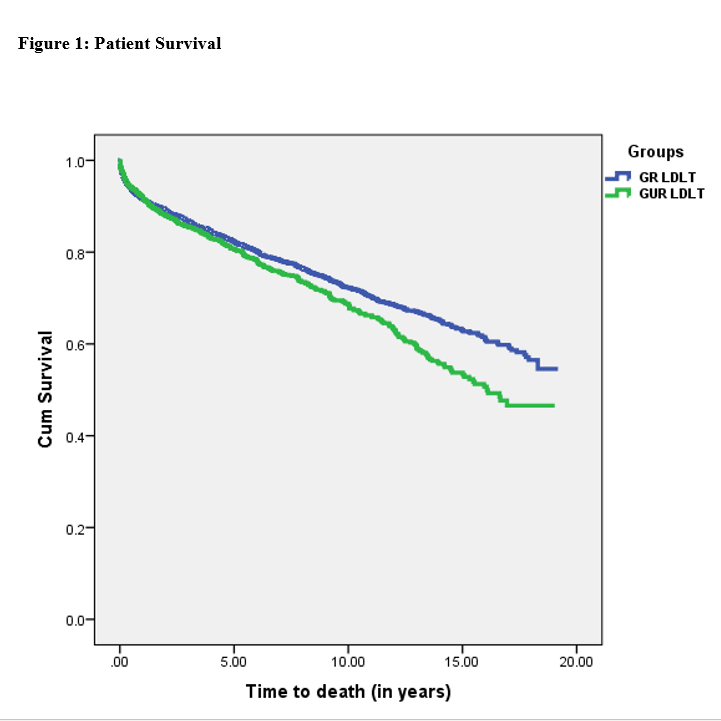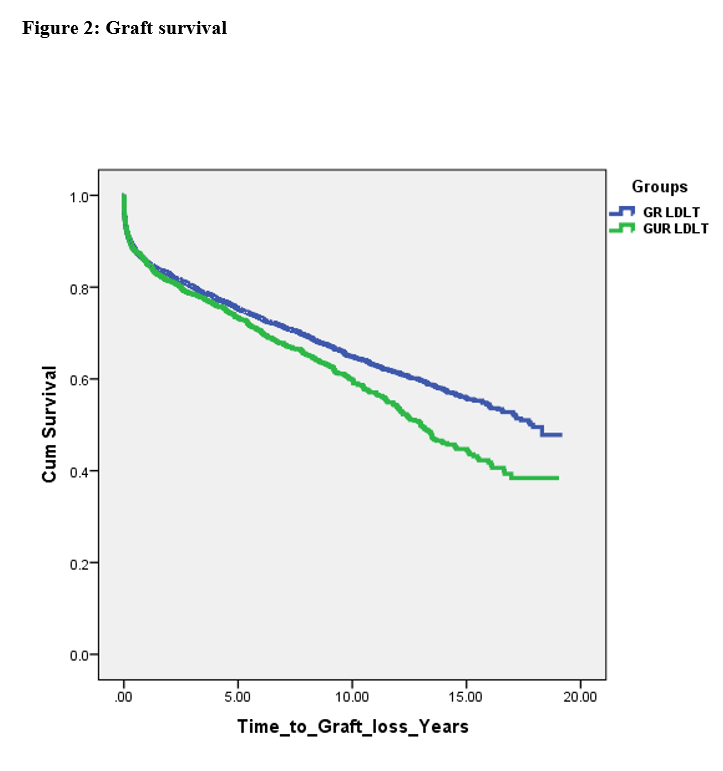Donor-Recipient Genetic Relationship and Outcomes of Living Donor Liver Transplantation (LDLT): Does it Really Matter?
A. M. Elsabbagh1, A. Mohamed1, E. M. Elsabbagh2, A. Al-Kurd1, T. Ivanics1, E. Ulrich1, T. Kitajima1, M. Rizzari1, K. Collins1, A. Yoshida1, M. Abouljoud1, S. Nagai1
1Henry Ford Hospital, Detroit, MI, 2University of Chicago Medical Center, Chicago, IL
Meeting: 2020 American Transplant Congress
Abstract number: 362
Keywords: HLA antigens, Humanized antibodies, Living donor, Living-related liver donors
Session Information
Session Name: Liver: Living Donors and Partial Grafts I
Session Type: Oral Abstract Session
Date: Saturday, May 30, 2020
Session Time: 3:15pm-4:45pm
 Presentation Time: 3:15pm-3:27pm
Presentation Time: 3:15pm-3:27pm
Location: Virtual
*Purpose: The impact of donor-recipient genetic relationship on LDLT outcomes has been raised by some recent reports. We sought to study this over a large patient population using the UNOS database.
*Methods: This was a retrospective analysis comparing genetically related (GR) adult and pediatric LDLT and genetically unrelated (GU) LDLT in the period between January 2000 and December 2017 using the UNOS database. Survival was evaluated using the Kaplan-Meier method. Multivariable Cox regression was performed to identify potential predictors of post-LT graft loss and mortality
*Results: 5656 cases were studied, GR group included 3945 and GU group included 1711 cases. Median age for GR group was 49 (0-78) year versus 51 (0-77) year for GU group (P=0.0001). Pediatric cases were 26.6% of GR group versus 9.8% of GU group (P=0.0001). 47.2 % were female in GR group versus 40.1 % in GU group (P = 0.0001). 5.8% were African American in GR group versus 3.7 % in GU group (P = 0.001). HLA data were found in 2149 cases. Median HLA mismatch level was 3 (0-6) in GR group versus 5 (0-6) in GU group (P=0.0001). A locus mismatch level was 2 in 9.3% of GR group versus 44.6% of GU group (P=0.0001). B locus mismatch level was 2 in 12.2% of GR group versus 70.6% of GU group (P=0.0001). DR locus mismatch level was 2 in 9.1% of GR group versus 57.5% of GU group (P=0.0001). The 3-, 5-, and 10-year patient survival for GR group was 85%, 80%, and 58% versus 83%, 78%, and 47% for GU group (P = 0.001). The 3-, 5-, and 10-year graft survival for GR group was 78%, 73%, and 51% versus 76%, 70%, and 38% for GU group (P = 0.0001). Biological relation was independent predictor of graft survival after modifying risk for age, gender, race using cox regression (P= 0.039).
*Conclusions: Genetic relationship was an independent predictor of long-term graft survival after LDLT. GR LDLT has more favorable outcomes compared with GU LDLT. HLA matching and/or adapting immunosuppression strategies may be recommended in LDLT from GUR donors.
To cite this abstract in AMA style:
Elsabbagh AM, Mohamed A, Elsabbagh EM, Al-Kurd A, Ivanics T, Ulrich E, Kitajima T, Rizzari M, Collins K, Yoshida A, Abouljoud M, Nagai S. Donor-Recipient Genetic Relationship and Outcomes of Living Donor Liver Transplantation (LDLT): Does it Really Matter? [abstract]. Am J Transplant. 2020; 20 (suppl 3). https://atcmeetingabstracts.com/abstract/donor-recipient-genetic-relationship-and-outcomes-of-living-donor-liver-transplantation-ldlt-does-it-really-matter/. Accessed December 14, 2025.« Back to 2020 American Transplant Congress


